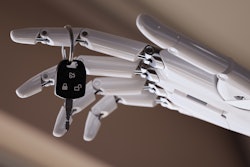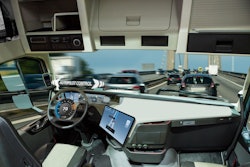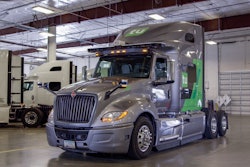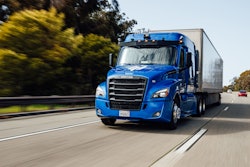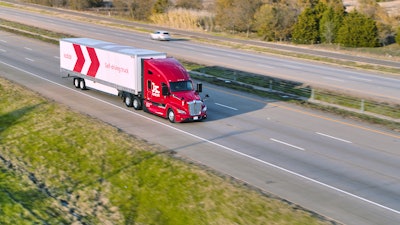
If you’ve ever seen an autonomous heavy-duty truck – or even an autonomous sedan for that matter – on the road, they look a bit different, heavily decked out in sensors on the front, top and sides of the vehicles.
Self-driving truck company Kodiak Robotics runs autonomous trucks 24/7 across the southern United States. Andreas Wendel, chief technology officer at Kodiak, said a common assumption is that it’s always sunny in the Sunbelt where Kodiak operates, and a common misconception is that it needs to be sunny – or at least clear weather – to operate an AV. Both are false, and Kodiak has designed its system to deal with all circumstances from pedestrians and construction to weather. And many of those odd-looking instruments on an AV are weather-related.
One in five vehicle accidents in the U.S. happen in adverse road weather conditions, and according to the Federal Motor Carrier Safety Administration, weather or environmental issues cause 3% of large truck accidents in the United States. Many trucking companies have started integrating weather data into their platforms to help prevent accidents as well as reroute loads driven by humans to keep them moving. AV developers have started doing the same, but there are still some blind spots to consider.
Wendel said Kodiak has a layered approach to dealing with weather. The first line of defense is forecasting. But there’s one human element that AV developers are still working on: road conditions that come as a result of weather. Kodiak uses cameras to assess road conditions and also has a partnership with Bridgestone in which the company uses Bridgestone’s tire sensor system to determine road conditions.
“Weather forecasts are pretty good, but they're not perfect, so you want to actually monitor what happens on the road as well,” Wendel said.
Another problem is predictability. As Wendel said, forecasts aren’t perfect. Weather changes all the time. So while an autonomous truck company can put a truck on the road that can then share weather and road condition data with the trucks coming behind it, where does that first truck of the day get its weather information from?
Knowing what’s ahead is really important, said Scott Mackaro, head of insights and innovation at Vaisala, a company that provides road weather data to the auto industry. Vaisala, which works with autonomous driving technology company Waymo, wants to improve weather and road condition data by installing sensors on roadways.
“Waymo has cars all over San Francisco. If there's a car in front of you half a mile, well, you know what the weather is half a mile up the road,” Mackaro said. “But for trucks, it's a whole different problem because you could be separated by 50 or 100 miles. There could be four thunderstorms in between.
“Our argument is that we should put sensors on the road, which is something that Viasala does in all the winter states. We have a pitch where we're saying, ‘We can put sensors every 10 kilometers between Houston and Dallas; that's a big corridor where (Waymo) is doing a lot of their testing,” he added. “Then when you integrate that into a model, we have really good coverage and predictive capability of what's going on.”
An example is ice. The weather is clear now, but maybe it rained earlier and the water on the road has since frozen.
“This is why we don't deal with just weather; we also have road models, because there can be a lag,” Mackaro said. “The car is driving on the road, not in the atmosphere. So it really is the impact of the atmosphere on the road. And sometimes there's time lag there. And you just don't want to be in an autonomous vehicle all of a sudden saying, ‘Oh, hey, I'm on ice.’ That's not really useful.”
Wendel said snowy and icy conditions are still a challenge for human drivers and AVs alike. Kodiak’s first reaction to weather conditions like rain, fog, smoke, sand and wind is to slow down, but snow and ice will shut the truck down altogether real quick. So Kodiak uses weather integration for rerouting as well.
“Really no sensor can help you drive (in those conditions),” he said.
Kodiak uses radar and lidar sensors to detect objects up ahead. The company will also be talking more later this year about its cleaning systems that use pressurized air and liquids to keep those sensors functioning properly.
Though sensors can only see so far ahead, they can still see farther than the human eye.
“Though we have those radar capabilities, and we can actually see through the fog. We still want to slow down and actually behave like a human driver because we don't want anyone else to be surprised,” he said. “You want to actually drive integrated in your environment. If everyone else doesn't see very well, you don't want to be the fastest vehicle on the road suddenly, even though you can see everyone else.”
That’s a major component to acceptance. Another component is sensors that alert a driver to take over. Kodiak AVs still have a “safety operator” on board to monitor the systems but also to take over driving on rare occasions when weather becomes too hazardous for the AV to handle on its own.
Wendel said Kodiak eventually wants to be entirely driverless.
Integrating weather into driver platforms across human-driven fleets is becoming more common, but Mackaro would argue that it’s even more important in the AV sector in order to gain public trust and therefore spur more widespread AV adoption.
“You can imagine it'll probably start with regulations requiring the drivers to have input during hazardous conditions,” he said. In fact, that would help us trust (autonomous technology) a lot more.”



